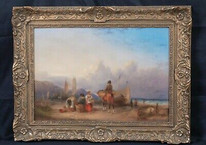19th Century French coastal landscape, oil on canvas by Richard Parkes Bonington. Excellent quality and condition small rocky coastal study with ships in the distance, probably in France or Holland. Signed bottom right, presented in a good antique gilt frame with artists plaque.
Provenance: A private West Sussex country estate collection
Measurements: 23" x 17" framed approx
Artist Biography
Born 25 October 1802, in Arnold, near Nottingham; died 23 September 1828, in London, from tuberculosis.
Painter, watercolourist, draughtsman, engraver, lithographer. History painting, landscapes with figures, landscapes, ruins, seascapes.
Richard Parkes Bonington learnt drawing at an early age under his father, a portrait and landscape painter. He came to France aged 15 when his father moved to Calais to go into the tulle and lace business. He was taught there by the watercolourist Louis Francia; he then moved on to Paris and began working at the Louvre, mostly on Flemish landscapes. Soon he met Delacroix, and in 1819 he was admitted to the cole des Beaux-Arts in Gros' studio. Though he quickly tired of academic compositions, his watercolour landscapes and seascapes showed promise, and Gros apparently encouraged and nurtured him in this direction.
Travelling around Normandy and Northern France, Bonington started to work directly from nature, producing two watercolours for the 1822 Salon. In the same year his talent for lithography was given full scope with the illustration of Baron Taylor's Picturesque Journey in France of Old ( Voyages Pittoresques) for which he provided the landscapes for Normandy and Franche-Comt and most memorably the Rue du Gros-Horloge in Rouen. He exhibited View from Abbeville at the 1824 Paris Salon. Having toured England with Delacroix in 1825, he was attracted to historical painting and composed, in the wake of Sir Walter Scott's Romantic outpourings, medieval and Renaissance scenes: Francis I and the Queen of Navarre, Henry IV and the Spanish Ambassador. Such pretexts for sumptuous settings and costumes would in turn have an impact on Delacroix. During that trip, he became acquainted with Turner's work, which was to mark a pivitol point in his development, turning him from Romanticism to Pre-Impressionism. In the spring of 1826 his stay in Italy, when he visited Naples, Florence, Milan, Bologna and most importantly Venice, resulted in several masterpieces including Venice, the Grand Canal and The Doge's Palace, Venice, exhibited at the 1827 Salon.
The last two years of his life were spent partly in Paris in his studio on the Rue St-Lazare, working all hours: he would stop only to entertain friends, the closest of whom was Delacroix. The rest of his time was spent in England. In 1826, he met Lawrence who, in a letter written just after Bonington's death, would assert that no untimely death could have taken away an artist with more promising a talent grown on so outstanding and swift a progress.
Bonington appeared at the onset of the great swing towards watercolour, at a time when, neglected in France, it took pride of place in England. He is the link between the French and the English Schools. For all the originality of Bonington's personal talent, the influence of Constable endured in his work. His landscapes, taken from nature, remain picturesque on the classical lines of the time. At a time when French masters favoured dark shades, they stood out by their colouring and light: clear tones, translucent shadows, limpid skies and waters.
He wrote Remnants and Fragments of Architecture in the Middle Ages ( Restes et Fragments d'Architecture au Moyen-Age) (1824) after a stay on the Channel coast. Unassuming and simple to a fault, Jules Jots remembers in his book St-Omer's School of Fine Arts how Bonington encouraged Cuvelier at his debuts. His gifts as a colourist opened new vistas for the Romantics. The importance he gave to light, to the sky, to their essence, helped to pave the way beyond Corot, for the immediate forerunners of Impressionism, Boudin and Jongkind, so that, together with Delacroix, he was the harbinger both of the end of Romanticism and of a new style of painting.
Group Exhibitions
1937, Pictures and Drawings by Richard Parkes Bonington and his Circle, Burlington Fine Arts Club, London
1939, Constable, Bonington, C. Pissarro, Stafford Gallery, London
1946, An Exhibition of Paintings, Drawings and Prints, by J.M.W. Turner, John Constable, R. P. Bonington, Museum of Fine Arts, Boston
1989, Richard Parkes Bonington (1802-1828), Paul Sandby (1730-1809): Wegbereiter der Aquarellmalerei (Richard Parkes Bonington (1802-1828), Paul Sandby (1730-1809): Precursors of Watercolour Painting), Stdt Galerie im Prinz-Max Palais, Karlsruhe
1999, The Golden Age of English Watercolour (1770-1900): Turner, Constable, Bonington..., Fondation de l'Hermitage, Lausanne
2001, An Enchanted Country. Italy Depicted by Artists from Thomas Jones to Corot, Palazzo del Te, Mantua
2003, From Ruskin to Turner: Drawings and Travels in Romantic Picardy (Ruskin-Turner. Dessins et voyages dans la Picardie romantique), Muse de Picardie, Amiens
2003, Bonington and his Contemporaries: Watercolours in the Wallace Collection, Wallace Collection, London (including 25 of his watercolours)
Solo Exhibitions
1942, Lyman Allyn Museum, New London, Connecticut
1962, Pictures, Watercolours and Drawings by R.P. Bonington, Thos. Agnew and Sons, London
1965, Castle Museum and Art Gallery, Nottingham
1966, Bonington: an English Romantic Painter in Paris (Bonington: Un Romantique Anglais Paris), Muse Jacquemart-Andr, Paris







